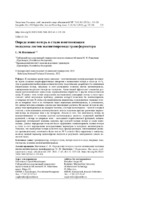| dc.contributor.author | Плотников, С. М. | |
| dc.coverage.spatial | Минск | ru |
| dc.date.accessioned | 2022-04-07T07:42:22Z | |
| dc.date.available | 2022-04-07T07:42:22Z | |
| dc.date.issued | 2022 | |
| dc.identifier.citation | Плотников, С. М. Определение потерь в стали и оптимизация толщины листов магнитопровода трансформатора = Determination of Steel Losses and Optimization of the Thickness of the Transformer Magnetic Conductor Sheets / С. М. Плотников // Известия высших учебных заведений и энергетических объединений СНГ. Энергетика. – 2022. – № 2. – С. 115-126. | ru |
| dc.identifier.uri | https://rep.bntu.by/handle/data/110970 | |
| dc.description.abstract | В настоящее время перед заводами – изготовителями трансформаторов поставлена задача создания энергоэффективных аппаратов с понижением потерь в стали до 44 %. Для ее реализации необходимы соответствующие теоретические разработки. Со снижением вихретоковых потерь, например за счет уменьшения толщины листов магнитопровода, одновременно возрастают потери на гистерезис. Аналогичный эффект дает изменение размеров кристаллического зерна стали, термомагнитная обработка и другие технологические меры. В связи с этим точное определение составляющих суммарных потерь в стали представляет собой актуальную проблему, решение которой позволило бы минимизировать суммарные потери. В статье проанализированы выражения, определяющие удельные потери на вихревые токи и на гистерезис через параметры магнитопровода, и установлено, что данная методика слишком сложна для инженерных расчетов. Поскольку потери на вихревые токи пропорциональны квадрату частоты, а потери на гистерезис – частоте в первой степени, с использованием ваттметрического метода получены простые расчетные выражения потерь на вихревые токи и на гистерезис. Исходя из того, что зависимость потерь на перемагничивание от толщины пластин магнитопровода является спадающей линейной функцией, а потерь на вихревые токи – восходящей параболической функцией, найдено выражение оптимальной толщины пластин, при которой полные потери в стали минимальны. Данная информация позволит более эффективно минимизировать полные потери в стали за счет варьирования конструктивных параметров и материала магнитопровода. Показано, что паспортные потери холостого хода трансформаторов, изготовленных разными производителями, отличаются более чем на 30 % и могут быть округлены и занижены, поэтому данный параметр целесообразно получать в результате эксперимента (опыта холостого хода). | ru |
| dc.language.iso | ru | ru |
| dc.publisher | БНТУ | ru |
| dc.title | Определение потерь в стали и оптимизация толщины листов магнитопровода трансформатора | ru |
| dc.title.alternative | Determination of Steel Losses and Optimization of the Thickness of the Transformer Magnetic Conductor Sheets | ru |
| dc.type | Article | ru |
| dc.identifier.doi | 10.21122/1029-7448-2022-65-2-115-126 | |
| local.description.annotation | Currently, transformer manufacturers are tasked with creating energy-efficient devices with a reduction of steel losses of up to 44 %. Appropriate theoretical developments are needed for its implementation. With a reduction of eddy-current losses, caused, for example, by reduction of decrease in the thickness of the magnetic conductor sheets, hysteresis losses simultaneously increase. A similar effect is caused by changing the size of the crystal grain of steel, thermomagnetic treatment and other technological impacts. In this regard, the exact determination of the components of total losses in steel is an urgent problem, the solution of which would minimize total losses. The article analyzes the expressions that determine the specific losses for eddy currents and hysteresis through the parameters of the magnetic circuit, and states that this technique is too complicated for engineering calculations. Since eddy current losses are proportional to the square of the frequency, and hysteresis losses are proportional to the frequency in the first degree, simple calculated expressions of eddy current and hysteresis losses have been obtained using the wattmetric method. Based on the fact that the dependence of the magnetization loss on the thickness of the magnetic conductor plates is a decreasing linear function, and the eddy current loss is an ascending parabolic function, an expression of the optimal thickness of the plates has been found, the implementation of which makes the losses of steel minimal. This information will make it possible to minimize total steel losses more effectively by varying the design parameters and the material of the magnetic conductor. It is shown that the charted idling losses of transformers manufactured by different manufacturers differ by more than 30 % and can be rounded and underestimated; therefore it is advisable to obtain this parameter as a result of an experiment (idling experiment). | ru |

